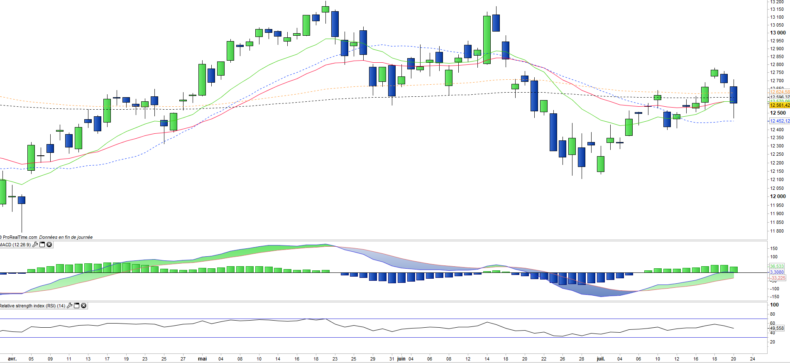DB X-Tracker DAX30 - DBXD - 23/07/2018
Short Term strategy: Negative (10%) / Trend -
Long Term strategy: Neutral (50%) / Trend =
pour accéder à nos achats / ventes sur les indices
Characteristics of the ETF
The DBXD ETF (db x-trackers), quoted in Euro, replicates the DAX 30 index which is composed of the 30 largest listed German securities, representative of the main sectors of the economy, while the stocks are selected according to the importance of their market capitalization.
The costs of this ETF are low at 0.09% and AUM is quite high at 3702M €, which makes it one of the best vehicles in terms of costs / liquidity. The replication method is direct (physical) and the dividend distribution is capitalized.
Alternative ETFS: DAX (Lyxor in Euro), DAXEX (Ishares in Euro)
Index & components
The top 10 stocks are mainly large industrial stocks such as Siemens or Bayer, while there are only 3 financial stocks: Allianz, Commerzbank and Deutsche Bank, the German master index is relatively small and mostly composed of large industrial groups.
Unlike the English, French or Italian indices, the DAX is also distinguished by the absence of large oil companies that weigh heavily in the weighting of the CAC40, FTSE100 or FTSEMIB40, which is double-edged according to the cycle specific to energy sector. In addition, the financials weigh only 15.9% of the index, half for the insurance giant Allianz, so the banking sector has a low weight reflected in the well-known weakness of Deutsche Bank and Commerzbank.
Conversely, the automotive and chemical sectors are heavier than the other European indices, while the technology sector is mainly represented by SAP (10.3%) whose market capitalization exceeds € 100 billion.
In summary, the DAX is a fairly strong index from a sectoral point of view which can make it evolve differently from other European indices. German fundamentals are very solid (GDP growth above 2%, historically low unemployment rate at 5.5% and accelerated deleveraging up to 2020). The main risks concern Germany's main customers, namely the United Kingdom, which could suffer from Brexit, the US in political uncertainty and threatening it with a trade war, Russia which remains a difficult and aggressive neighbor and China because of its commercial practices which also tend to limit access to its domestic market to Western industrialists, particularly in the automotive and technology sectors.
Latest developments
After an increase of 6.9% in 2016, the DAX30 grew by 12.5% in 2017, more than the stoxx600 (+ 10.6%). But the index has fallen -2.8% since the beginning of the year, which is a lower performance than the Stoxx600NR (+ 1.2%), which is due to the risk of trade war with the US.
The German economy is based on exports and has everything to lose in a trade war and the general increase of tariffs. The next meeting between D.Trump and JC. Junker on July 25th to try to reach an agreement on the automotive sector may be crucial for the index because the US have already warned that in the absence of a satisfactory agreement they would apply a 25% tax on European imports.
The 3 largest German manufacturers account for around 10% of the capitalization of the DAX and would be particularly affected by the application of this tax.
Weekly data
On the weekly chart, we can see an uptrend but which has become more hesitant for a year, and especially after the peak achieved in early 2018. The formation of a head & shoulder structure with a neck line around 12,000 pts is also worrying because it carries a risk of decline up to 10500 pts. The prices mark an hesitation and are on pivotal levels. The major medium term support remains the EMA100 which is not far from the neckline of the H&S.
Daily data
The daily chart shows an attempt to rebound and then retreat at the end of the week, but prices remain at the moving averages level, leaving the scenario quite open. The short-term oscillators remain positive, which gives the rebound a chance. The busy week in events should decide on the continuation of the movement which remains for the moment rather little directional. A renewed volatility is possible over the next few days.
ETF objective
DBXD is a UCITS ETF listed in EUR, which seeks to replicate the DAX index (30 German companies)
Characteristics
| Inception date | 10/01/2007 |
| Expense ratio | 0,09% |
| Issuer | Lyxor |
| Benchmark | Indice DAX 30 |
| Code/Ticker | DBXD |
| ISIN | LU0274211480 |
| UCITS | Yes |
| Currency | € |
| Exchange | XETRA |
| Assets Under Management | 3 702 M€ |
| Replication Method | Direct (Physical) |
| Dividend | Capitalization |
| Currency Risk | No |
| Number of Holdings | 30 |
| Risk | 3/5 |
Country Breakdown
| Germany | 100% |
Sector Breakdown
| Consumer Discretionary | 16% |
| Financials | 16% |
| Materials | 15% |
| Health Care | 14% |
| Industrials | 14% |
| Technology | 13% |
| Telecom | 4% |
| Others | 9% |
Top Ten Holdings
| Siemens | 10% |
| SAP | 10% |
| Bayer | 8% |
| BASF | 8% |
| Allianz | 8% |
| Daimler | 5% |
| Deutsche Telekom | 4% |
| Adidas | 4% |
| Linde | 4% |
| Fresenius | 3% |


